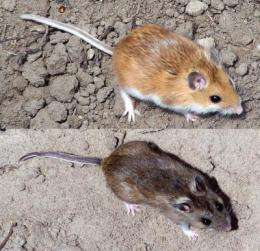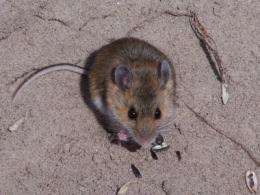Mice living in sandy hills quickly evolved lighter coloration

In a vivid illustration of natural selection at work, scientists at Harvard University have found that deer mice living in Nebraska's Sand Hills quickly evolved lighter coloration after glaciers deposited sand dunes atop what had been much darker soil. The work is described this week in the journal Science.
Co-authors Catherine R. Linnen and Hopi E. Hoekstra show that the different variants of a single gene determines whether a deer mouse is dark or pale -- a small difference with huge survival implications for a species widely hunted by owls, hawks and other visual predators.
"Our work shows that rapid adaptive change, such as the evolution of lighter coloration among Sand Hills mice, need not always rely on pre-existing genetic variation," says Linnen, a postdoctoral researcher in Harvard's Department of Organismic and Evolutionary Biology. "We show that a single genetic change creates lighter coloration in these mice, and that this variant clearly arose recently, sometime after the formation of the Sand Hills."

The species Linnen and Hoekstra studied, Peromyscus maniculatus, is the most widespread mammal in North America. By analyzing the strength of natural selection in favor of lighter Sand Hills mice, the scientists determined that predation would drive virtually all individuals in the area toward pale coloration within 8,000 years -- just slightly less than the age of the Sand Hills.
This and other evidence, including much greater genetic uniformity among pale mutants than their dark wildtype cousins, suggests this mutation is a relatively recent development, likely arising shortly after the formation of the Sand Hills in north-central Nebraska.
Linnen and Hoekstra found that light coloration arises from increased activity in a single gene, called Agouti. This increased expression, in turn, is associated with the deletion of a single amino acid, a process that appears to be under natural selection. This Agouti mutation generates wider pale bands on dorsal hairs, making the entire animal appear golden rather than brown.
"This work sheds new light on the forces affecting diversity in nature," says Hoekstra, John L. Loeb Associate Professor of the Natural Sciences in Harvard's Faculty of Arts and Sciences. "It's an exciting time in biology, with the integration of field studies, genetic analysis, and developmental and molecular biology enabling us to connect genes and molecular mechanisms with species' traits in the wild. In the bicentennial of Charles Darwin's birth and on the 150th anniversary of his publication of On the Origin of Species, this study vividly illustrates the power of natural selection."
The Sand Hills, rolling dunes occupying more than a quarter of Nebraska's area, were created by glacial deposition of sand sometime in the last 10,000 years. Since the soils of these hills are composed mostly of light-colored quartz grains, pale mice are better camouflaged against owls and other raptors. Surrounding areas, with much darker soils, tend to be occupied by dark brown mice.
By mating light Sand Hills mice and dark mice found outside the Sand Hills, Linnen and Hoekstra determined that the light coloration seen in Agouti mutants is genetically dominant to the darker coats seen among wildtype mice.
Source: Harvard University (news : web)


















